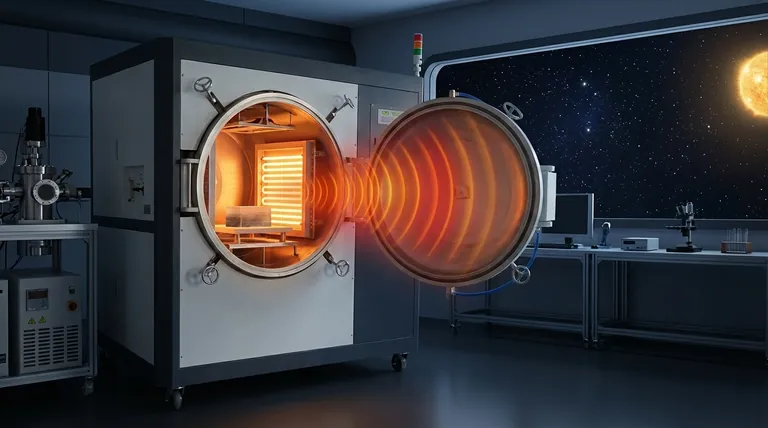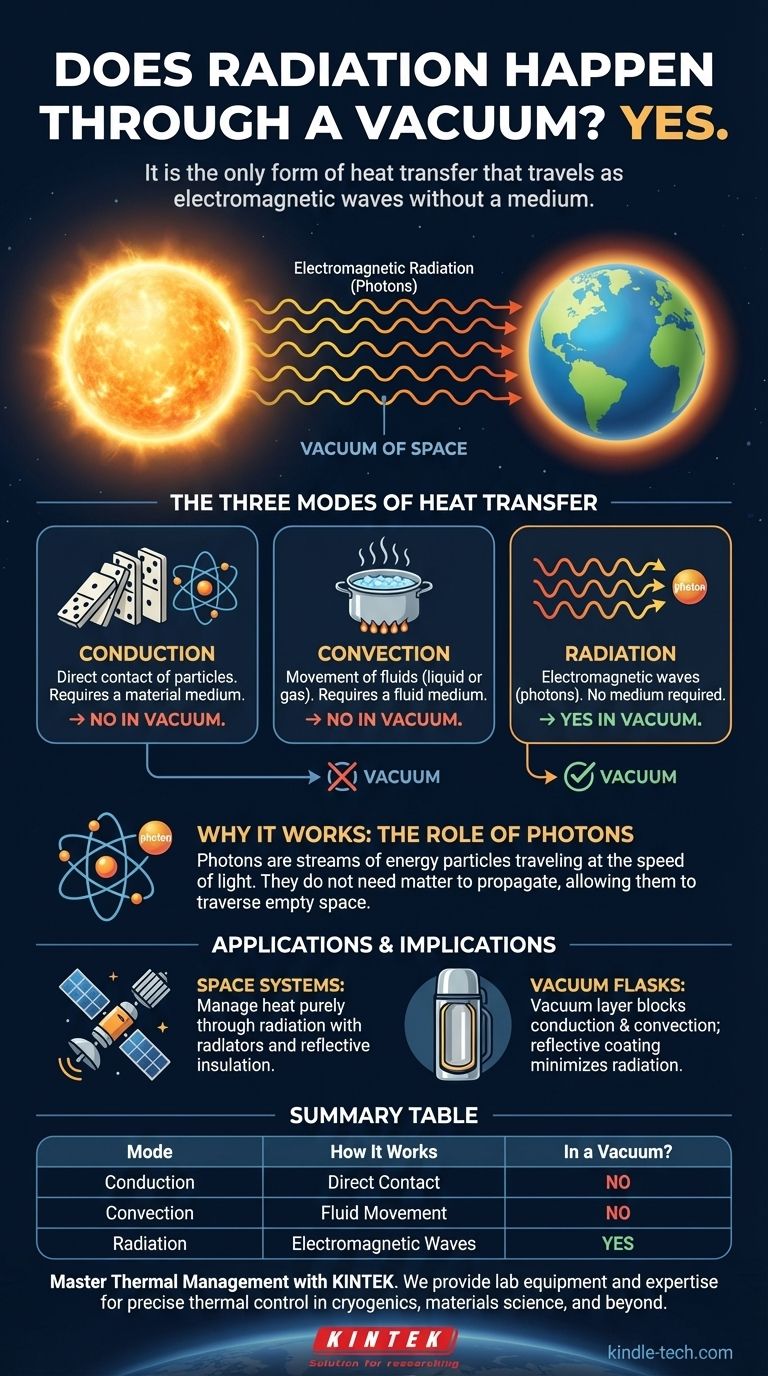Yes, unequivocally. Radiation is the only form of heat transfer that can occur through a perfect vacuum. It does not require a medium because it travels as electromagnetic waves, just like light. This is precisely how the Sun's energy travels across the vast emptiness of space to warm the Earth.
While a vacuum is an almost perfect insulator against conduction and convection, it is the ideal pathway for heat transfer by radiation. This is because radiation is not the movement of matter, but the movement of energy itself in the form of photons.

The Three Modes of Heat Transfer
To understand why radiation works in a vacuum, we must first distinguish it from the other two methods of heat transfer. Each operates on a fundamentally different principle.
Conduction: The Domino Effect
Conduction is the transfer of heat through direct contact. Atoms in a hotter region vibrate more intensely, bump into their neighbors, and transfer that vibrational energy along the line.
Think of it like a row of dominoes. The first one falls and triggers the next, and so on. This process requires a medium—a chain of particles to pass the energy along.
Convection: The Moving Fluid
Convection is the transfer of heat through the movement of a fluid (a liquid or gas). When part of a fluid is heated, it becomes less dense and rises, while the cooler, denser fluid sinks to take its place.
This creates a circulating current that distributes heat. A boiling pot of water is a classic example. This process requires a fluid medium that can move.
Radiation: The Wave of Energy
Radiation is the transfer of heat via electromagnetic waves, primarily in the infrared spectrum. Any object with a temperature above absolute zero (-273.15°C) emits this radiation.
Unlike conduction or convection, these waves are streams of energy particles called photons. They do not require any medium to travel from their source to a destination.
Why a Vacuum is No Obstacle for Radiation
The unique nature of radiation is what allows it to traverse the void. The absence of matter, which stops conduction and convection, is irrelevant to radiative heat transfer.
The Role of Photons
Heat radiation is fundamentally the same phenomenon as visible light, radio waves, and X-rays—it is all electromagnetic radiation. It's just energy, carried by photons, traveling at the speed of light.
Because photons can travel through empty space, the heat energy they carry can move from a hot object (like the Sun) to a cold object (like the Earth) without anything in between.
The Sun: Our Ultimate Example
The space between the Sun and Earth is a near-perfect vacuum. The Sun's immense heat cannot reach us through conduction or convection because there are virtually no particles to facilitate that transfer.
Instead, the Sun radiates a colossal amount of energy in all directions. A tiny fraction of this energy travels 93 million miles through the vacuum of space, is absorbed by our planet's atmosphere and surface, and provides the warmth necessary for life.
The Critical Difference: Insulation vs. Propagation
The fact that a vacuum stops two forms of heat transfer but allows another has profound practical implications. It can be used both as an excellent insulator and an unavoidable pathway for energy.
Why Conduction and Convection Fail
In a vacuum, there are no atoms to vibrate against each other, making conduction impossible.
Likewise, there is no gas or liquid to form currents, making convection impossible. A vacuum is the absence of a medium, and both of these processes depend entirely on one.
The Power of a Vacuum Flask
This principle is exactly how a Thermos or vacuum flask works. These containers have an inner and an outer wall separated by a vacuum.
This vacuum layer dramatically reduces heat transfer by conduction and convection, keeping hot liquids hot and cold liquids cold. The only significant way heat can still move is through radiation, which is why these flasks have reflective silver coatings to minimize even that.
Applying This Knowledge to Your Goal
Understanding how heat behaves in a vacuum is a core principle in fields ranging from cryogenics to aerospace engineering.
- If your primary focus is space systems: You must design spacecraft to manage heat purely through radiation, using large radiators to shed waste heat into space and reflective insulation to protect sensitive components from solar radiation.
- If your primary focus is creating insulation: You can leverage a vacuum to build highly effective thermal barriers, as seen in insulated glass windows, cryogenics transport, and vacuum flasks.
- If your primary focus is fundamental physics: Remember that all objects above absolute zero radiate energy, and this process is governed by electromagnetism, not just particle-based thermodynamics.
By understanding that radiation is simply energy in motion, you can predict and control its behavior in any environment, from a coffee cup to the cosmos.
Summary Table:
| Mode of Heat Transfer | How It Works | Can It Work in a Vacuum? |
|---|---|---|
| Conduction | Transfer through direct contact of particles (like dominoes). | No - Requires a material medium. |
| Convection | Transfer through the movement of a fluid (liquid or gas). | No - Requires a fluid medium. |
| Radiation | Transfer via electromagnetic waves (photons), like light. | Yes - Requires no medium; travels through empty space. |
Master Thermal Management in Your Lab
Whether you are designing for extreme insulation or need to manage heat in specialized environments, understanding radiative heat transfer is critical. KINTEK specializes in lab equipment and consumables that help you control and apply these fundamental principles.
We provide the tools and expertise to support your work in cryogenics, materials science, and beyond. Let us help you achieve precise thermal control.
Contact our experts today to discuss your specific laboratory needs and how our solutions can bring value to your research.
Visual Guide

Related Products
- Vacuum Heat Treat Furnace with Ceramic Fiber Liner
- Molybdenum Vacuum Heat Treat Furnace
- Vacuum Heat Treat Sintering Brazing Furnace
- 2200 ℃ Tungsten Vacuum Heat Treat and Sintering Furnace
- High Pressure Laboratory Vacuum Tube Furnace Quartz Tubular Furnace
People Also Ask
- What is the leak rate for a vacuum furnace? Ensure Process Purity and Repeatability
- Can I vacuum the inside of my furnace? A Guide to Safe DIY Cleaning vs. Professional Service
- What is the maximum temperature in a vacuum furnace? It Depends on Your Materials and Process Needs
- What materials are used in a vacuum furnace? Selecting the Right Hot Zone for Your Process
- How to vacuum out a furnace? A Step-by-Step Guide to Safe DIY Maintenance



















